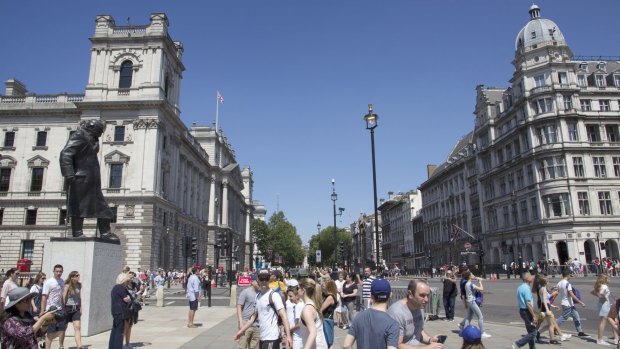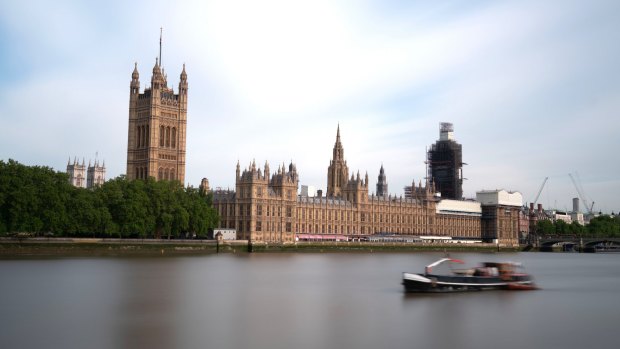This was published 4 years ago
Tour Winston Churchill's London: The ghost that inhabits London like no other
By Steve Meacham

Winston Churchill statue in Parliament Square, London.Credit: iStock
Legend has it that in 1951 Winston Churchill was asked to approve another statue to be added to those illustrious figures already adorning London's Parliament Square. It was the prime spot, on the south-eastern corner, directly opposite the Houses of Parliament. "I have someone else in mind for that!" the story goes, clearly referring to himself. (The same man said, "History will be kind to me because I intend to write it" - before winning the Nobel Prize for Literature.)
So, any tour of Churchill's London should start in Parliament Square. He never saw the indomitable, trench-coated statue by Welsh sculptor Ivor Roberts-Jones. It wasn't unveiled until 1973, eight years after his death, aged 90. But he would have approved. There's no cigar, no V-for-Victory sign. Instead he's leaning on a cane - challenging every subsequent parliamentarian to live up to his legacy. Churchill wasn't born in London, nor is he buried here. Yet his ghost inhabits Britain's capital like no other politician - or monarch.
CHURCHILL WAR ROOMS

The Palace of Westminster.Credit: Bloomberg
There's no more evocative reminder of the challenges facing Britain in 1940 than this warren of subterranean corridors and store rooms beneath Whitehall which became Churchill's wartime command centre from the Blitz to the surrender of the Japanese in 1945. Part of the Imperial War Museum, the complex was extensively remodelled in 2005 and now contains the expansive, interactive Churchill Museum - charting his full, fascinating and controversial life - as well as the historic Cabinet War Rooms, first opened to the public in 1984.
Churchill held 114 wartime cabinet meetings here, first visiting the top secret complex after becoming Prime Minister in May 1940 and declaring: "This is the room from which I will direct the war!" It's impossible to convey the cramped, unsanitary conditions in which Churchill, his military chiefs, long-suffering secretaries, longer-suffering wife Clemmie, and personal chef worked while bombs devastated street level London. (Note the chamber pot in Churchill's bedroom: no room for ensuites!)
Three rooms stand out. The Map Room where every defeat, setback and eventual victory was updated via technology now quaint and antiquated. The War Cabinet Room itself where Churchill held court. And the grandly-titled cubicle known as the "Transatlantic Telephone Room" where Churchill talked with President Roosevelt - on an encrypted phone line relayed (incredibly) via Selfridges department store! Allow at least 90 minutes and book ahead. See iwm.org.uk
HOUSE OF COMMONS
Churchill, an aristocrat, was descended from John Churchill, the general whose victory at Blenheim earned him the title of Duke of Marlborough and the wherewithal to build Blenheim Palace - one of England's most beautiful stately homes.
Winston was born at Blenheim, prematurely. The rumour he was delivered in the ladies toilet because Jennie, his socialite American heiress mother, was attending a ball is untrue (she'd "fallen while walking with a shooting party" and Winston's birth had been planned for the parental home, 48 Charles Street, Mayfair).
Winston was also offered a Dukedom, by the present Queen, turning it down because it might have affected any descendant from sitting in the House of Commons (he accepted the Knight of the Garter instead).
Churchill's parliamentary career was inconsistent. He swapped parties (a progressive Liberal minister when he championed Gallipoli - a hard-right Conservative when he smashed Britain's General Strike of 1926). During his 64 years as an MP, he represented five constituencies, and was the only politician to serve under both Queen Victoria and Queen Elizabeth II.
The Commons was his theatre, just as radio was his medium. His contribution to democracy ("the worst form of government except for all those other forms that have been tried") is evident throughout Parliament. After clearing security, you'll enter Westminster Hall, saved from the calamitous fire in 1834 that destroyed most of the ancient Palace of Westminster.
Huge events in British history took place here, including the trial of King Charles I. But a plaque marks where Churchill's body lay in state. Later - after the ceremonial grandeur of the House of Lords - you'll come to the entrance of Commons, dominated by statues of two of Britain's most influential Prime Ministers. Margaret Thatcher - high-heeled, hairdo immaculate, and hectoring - seems to be admonishing the equally belligerent Churchill. His statue, by his favoured sculptor Oscar Nemon, depicts him in parliamentary garb, mid-stride towards the dispatch box.
The Commons entrance itself is known as the Churchill Arch, rebuilt - at Winston's own suggestion - from original stonework when the House of Commons was bombed in World War II.Details: Allow two hours and book ahead, see parliament.uk.
ST MARGARET'S CHURCH, WESTMINSTER
A crucial spot in any Churchill odyssey, Churchill married Clementine Hozier here on September 12, 1908. Their marriage was not only loving (there are countless love letters from Churchill to prove it), but vital to the defeat of Nazism. "Clemmie" - who had her own bedroom in the cabinet war rooms - was perhaps the only person (other than Roosevelt or Stalin) he listened to. The parliamentary Victory in Europe service was also held in this 15th Century Anglican church opposite parliament. See westminster-abbey.org
WESTMINSTER ABBEY
Every English monarch has been crowned in one of Europe's greatest medieval cathedrals since the Norman original was built on the orders of William the Conqueror. Churchill is remembered in a memorial unveiled by the Queen to mark the 40th anniversary of the Battle of Britain. See westminster-abbey.org
ST PAUL'S CATHEDRAL
No building signified British resistance to Hitler's Blitz more than the Churchillian-domed profile of Christopher Wren's masterpiece surviving each nightly Luftwaffe inferno. Churchill knew the propaganda value, ordering the much-beleaguered fire services to defend St Paul's at all cost. So it's fitting his state funeral took place here on January 30, 1965. Few non-royals are granted a state funeral in Britain. Churchill's was the last: his coffin was carried by Thames boat and horse-drawn carriage from Westminster to St Paul's. Then, by special steam train, to his burial place at Bladon in Oxfordshire. See stpauls.co.uk.
HARROW SCHOOL, NORTH LONDON
Churchill was an unhappy child, sent to boarding school when he was seven. His teenage years were spent at Harrow (Eton's main rival). Former Harrow students include Prime Ministers Robert Peel and Lord Palmerston, plus poet Lord Byron - yet today, it's known primarily as Winston's alma mater. Despite his pleas, his mother rarely bothered to visit - though that was better than his father, politician Lord Randolph Churchill, he visited his son once. However young Winston excelled at fencing, developed a prodigious memory and eventually was accepted at the Royal Military College Sandhurst (without ever passing the entrance exam). One of his famous wartime speeches ("Never give in. Never, never, never!") was made at his old school in 1941. Public tours taking in "The Old Speech Room" - containing Churchill memorabilia, including his paintings - operate three times a year. See harrowschool.org.uk.
SIX OF WINSTON'S LONDON ABODES
28 HYDE PARK GATE, KENSINGTON His last London home. He and Clemmie bought it in 1945, after he'd lost the 1945 election to Labour's Clem Atlee. It's the only home to bear an English Heritage Blue Plaque saying: "Sir Winston Churchill KG, Prime Minister, 1874-1965, lived and died here."
105 MOUNT STREET, MAYFAIR The bachelor apartment he moved into in 1900 after resigning from the army, standing for the first time - unsuccessfully - for parliament, and becoming a war correspondent in South Africa.
12 BOLTON STREET, MAYFAIR The redbrick terraced house where he was living when he first met Clemmie.
33 ECCLESTON PLACE, PIMLICO This grand porticoed house was the first home Winston and Clemmie purchased together, and where their first children - Diana and Randolph - were born. Churchill's career rose beyond even (possibly) his own expectations. In quick succession, he became what (in Australia) we'd now call Trade Minister, Minister of Home Affairs and Defence Minister as World War I approached.
ADMIRALTY HOUSE, WESTMINSTER Like his parents, Churchill lived beyond his means. So it was a godsend when he was appointed First Lord of the Admiralty, a position which came with a four-storey 18th Century house in Whitehall. The family lived here from 1911 to 1915, returning briefly following Hitler's invasion of Poland.
DOWNING STREET, WESTMINSTER Following many terrorist attacks, Downing Street was fenced off. However Winston lived in Number 11 from 1924-1929 as Stanley Baldwin's Chancellor of the Exchequer (finance minister). The historic door of Number 10 - official residence of the First Lord of the Treasury (another name for Prime Minister) is now preserved in the Churchill Museum, a reminder of its most famous inhabitant.
TRIP NOTES
FLY
Cathay Pacific flies to London daily from Sydney and Melbourne, see cathaypacific.com
Sign up for the Traveller Deals newsletter
Get exclusive travel deals delivered straight to your inbox. Sign up now.